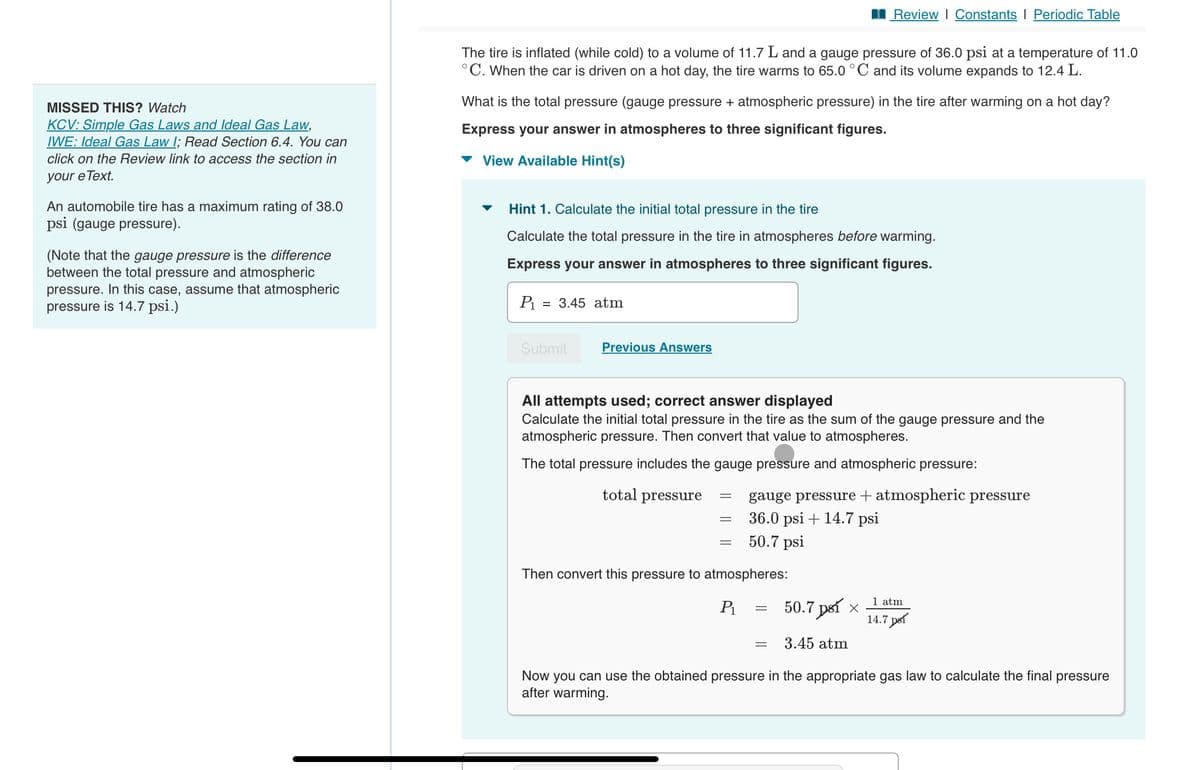MISSED THIS? Watch KCV: Simple Gas Laws and Ideal Gas Law, IWE: Ideal Gas Law I; Read Section 6.4. You can click on the Review link to access the section in your e Text. An automobile tire has a maximum rating of 38.0 psi (gauge pressure). (Note that the gauge pressure is the difference between the total pressure and atmospheric pressure. In this case, assume that atmospheric pressure is 14.7 psi.) The tire is inflated (while cold) to a volume of 11.7 L and a gauge pressure of 36.0 psi at a temperature of 11.0 °C. When the car is driven on a hot day, the tire warms to 65.0 °C and its volume expands to 12.4 L. What is the total pressure (gauge pressure + atmospheric pressure) in the tire after warming on a hot day? Express your answer in atmospheres to three significant figures. ▾ View Available Hint(s) Hint 1. Calculate the initial total pressure in the tire Calculate the total pressure in the tire in atmospheres before warming. Express your answer in atmospheres to three significant figures. P₁ = 3.45 atm Submit Previous Answers All attempts used; correct answer displayed Calculate the initial total pressure in the tire as the sum of the gauge pressure and the atmospheric pressure. Then convert that value to atmospheres. The total pressure includes the gauge pressure and atmospheric pressure: total pressure = Review | Constants I Periodic Table = gauge pressure + atmospheric pressure 36.0 psi + 14.7 psi = 50.7 psi Then convert this pressure to atmospheres: P₁ = 50.7 psí x 3.45 atm Now you can use the obtained pressure in the appropriate gas law to calculate the final pressure after warming. = 1 atm 14.7 p
Ideal and Real Gases
Ideal gases obey conditions of the general gas laws under all states of pressure and temperature. Ideal gases are also named perfect gases. The attributes of ideal gases are as follows,
Gas Laws
Gas laws describe the ways in which volume, temperature, pressure, and other conditions correlate when matter is in a gaseous state. The very first observations about the physical properties of gases was made by Robert Boyle in 1662. Later discoveries were made by Charles, Gay-Lussac, Avogadro, and others. Eventually, these observations were combined to produce the ideal gas law.
Gaseous State
It is well known that matter exists in different forms in our surroundings. There are five known states of matter, such as solids, gases, liquids, plasma and Bose-Einstein condensate. The last two are known newly in the recent days. Thus, the detailed forms of matter studied are solids, gases and liquids. The best example of a substance that is present in different states is water. It is solid ice, gaseous vapor or steam and liquid water depending on the temperature and pressure conditions. This is due to the difference in the intermolecular forces and distances. The occurrence of three different phases is due to the difference in the two major forces, the force which tends to tightly hold molecules i.e., forces of attraction and the disruptive forces obtained from the thermal energy of molecules.
P2=_____atm

Trending now
This is a popular solution!
Step by step
Solved in 3 steps with 1 images









